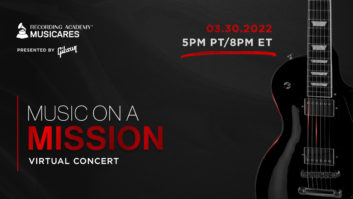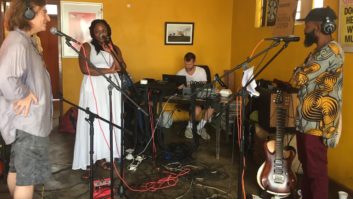The realm of contemporary African-based world music has been mostly dominated by male singers and griots (traditional oral historians) such as Baaba Maal, Salif Keita, King Sunny Ade, Youssou N’Dour, and Femi Kuti, who carries on the Afro-beat legacy of his father, Fela Kuti. However, Angélique Kidjo, who hails from Benin, West Africa, puts a uniquely feminine spin on the genre. The result is that her career has blossomed in the past few years and has developed a strong international following. In terms of her musical approach, Kidjo is more pop-oriented than other African artists, and she is quick to note that Western icons such as Carlos Santana, The Beatles, James Brown and Aretha Franklin are important influences on her.
In 1991, she took the world-beat scene by storm with the Afro dance hit “Batonga,” which was a track from her Logozo CD. After that initial hit, she created a string of worldly pop recordings that mixed elements of traditional African folk with rock, R&B, jazz and electronica. Much like her personality, the music was mostly upbeat and playful, but also very direct. Then, starting with Oremi, which was released in 1998, Kidjo embarked on a three-CD quest to showcase and celebrate her musical origins and the path that African music has taken in moving over to North and South Americas. “The general theme of the trilogy is to follow the roots of the music that has been brought to America, Brazil, Cuba, Caribbean and New Orleans by the slaves,” Kidjo says. “The first part was in New York with Peter Mokran as the producer. On it, I had Branford Marsalis [saxophone], Cassandra Wilson [vocals], Kenny Kirkland [keyboards], Kelly Price [vocals], Robbie Neville [vocals] and Ahmir Thompson [drums] from The Roots.” That project emphasized the link between African music and American R&B.
For the second installment, the recently released Black Ivory Soul, co-produced by Kidjo, her bassist/husband Jean Hébrail and Bill Laswell, the focus was on the connection between Africa and Brazil, particularly in the city of Bahia, which Kidjo visited for the first time in 1999. Kidjo says that Bahia reminded her of her own home village, Quidah, with the food, vegetation and, most importantly, the similar rhythms of the local music. She had traveled to Brazil previously on tour with Malian vocalist/guitarist Ali Farka Toure, and while other parts of the remarkable country touched her, they didn’t have quite the same impact Bahia had. After all, Benin and Bahia were a source and destination, respectively, of the slave trade and share common ancestry.
“It was a shock going to Bahia,” says the New York-based Kidjo, who sings in French, English, and the African languages Yoruba and Fon. “People told me it was just like my home, but I didn’t believe it till I saw it. You see more black people than white people, and I thought, ‘Where am I?’ I felt I had to do something musically before I went. And being there just emphasized it and made it more urgent than anything else.”
Less than a year after that visit to Bahia, the singer returned with her husband, Pro Tools rig in tow, to capture the sound of Bahian drumming. At the same time, she connected with Carlinhos Brown, one of the region’s heralded percussionists, to create many of the songs for Black Ivory Soul. (Additionally, Kidjo collaborated with Brazilian singer Daniela Mercury for two compositions that ended up on Mercury’s latest CD.)
“They were some of the basic tracks that we used on the album,” says Hébrail. “For the first song on the CD ‘Bahia’ [and several others], the basic production was done in Brazil. Once we were back in New York, we put together a guide vocal with light production and the musicians would play on top of it.” In addition to playing bass, Hébrail did some engineering for the sessions at Sear Sound, and “I wrote a lot of songs with Angèlique for this project. In the studio, with all the musicians, I was mostly watching because there was an engineer there [Clark Germain]. I would give some input to the musicians, but Angélique was really on top of things.”
Surprisingly, in all her years of recording, going back to her self-produced debut, Pretty [1998], Kidjo had never worked in the old-school manner of tracking most of the instruments at once. “I like it very much live in the studio,” she comments. “I wanted to do that for a long time. Most of the time, I hate studios, it’s not my culture. I’m much more of a stage or live person than anything else. But the fact that I had all musicians in the studio made the equipment just disappear. It’s definitely way more fun, and you can see people coming to your world. I wrote these songs with my husband, and then you’re in studio and you see them grow. It’s pretty inspiring, like seeing a child grow up.”
Furthering the development of Kidjo’s songs was a virtual United Nations of musicians, including guitarists Romero Lubambo (Brazil), Jao Mota (Guinea Bissau) and Dominic Kanza (Congo), bassists Michel Alibo (West Indies) and Ira Coleman (New York), drummer Ahmir Thompson (Philadelphia), kora player Mahamadou Diabate (Guinea), keyboardist Bernie Worrell (New York), percussionist Abdou M’boup (Senegal) and others. The midsized studio was barely able to contain all of the players for the sessions. The size of the studio wasn’t an issue, but communication between the players was. “Nobody could speak together and they didn’t understand each other,” recalls Hébrail. “But as soon as the music started, they didn’t need words. It was magical to see the link between Brazilian, American and African grooves. The first 10 minutes were incredible and showed that you don’t need words to make music.”
To capture the energy of the sessions, Kidjo and Hébrail tapped engineer/guitarist Clark Germain, who’s based in Southern California but commutes regularly to New York for recording dates. Germain has also done a substantial amount of work in Spain, Italy and Cuba, working with such notable artists as jazz pianists Chick Corea and Herbie Hancock, Cuban guitarist Eliades Ochoa (Buena Vista Social Club), percussionist Poncho Sanchez and vocalist Madame Bongo. In 2000, Germain and Bill Schnee were nominated for an Engineering Grammy for their work on David Benoit’s Here’s to You, Charlie Brown!: 50 Great Years. Germain has become something of a specialist at recording acoustic ensembles, so working on the Kidjo project, with its blend of acoustic and electric instruments, was a natural for him.
“The joy of working at Walter’s place [Sear Sound, owned by Walter Sear] was the mic choices I had,” Germain says. “I used the KM-54 quite a bit, C-12As, and he’s got a lot of classic older tube mics that are in pristine shape.” Germain had worked at Sear on other occasions and recommended it to Kidjo. Besides the mic selection, he also loves the room’s classic Neve board with its preamps that let him get what he calls “the fattest sound possible.” Though Sear Sound is well-stocked with the best analog equipment, the ultimate destination of the music on these sessions was Pro Tools.
For about a week in the fall of 2000, Kidjo and her cast of international players jammed relentlessly, with players moving in and out of the lineup as the songs’ and the musicians’ schedules dictated. “Based on the instrumentation, each song was quite a bit different,” Germain recalls. “We had a selection built around the za-bar drums, which are very loud. That was very different, and some song ideas were built around the kora [African thumb piano], too. Each day pretty much brought new surprises, making it a challenge and a lot of fun from that standpoint.” Naturally, with most of the musicians in one room and only three iso booths, there were some leakage problems. But from his experiences recording orchestras for film scores with no iso booths and from working with jazz ensembles, Germain has learned how to manage the leakage; indeed, to turn it to his advantage by building a bigger sound.
For her part, Kidjo was delighted with how the sessions went. Her only complaint is that a few of the musicians she hoped to have on the record were unable to appear due to scheduling conflicts. “If I had done all the collaborations that I wanted to,” she says, “this CD would have more than 12 songs on it. There are so many gifted artists in Brazil, but I went for the ones that were available. I really wanted Caetano Veloso and Gilberto Gil, but they were very busy.” Fortunately, Brazilian guitarist Vinicius Cantuaria lived about a block away in Brooklyn. But renowned musicians such as percussionist Carlinhos Brown and vocalist/guitarist Dave Matthews were also extremely difficult to schedule sessions with.
“Nailing Carlinhos down was tough,” she says, “so we decided I would come back [from Brazil] to New York and he would tell me when he was available. When that happened, I just jumped on a plane and did the work there. For Dave Matthews, I was touring with him last summer and had already finished the recording. I gave him the CD and explained the meaning of the song [“Iwoya”], because there were no lyrics on it at that time. I told him that I really wanted him to sing with me when he felt like it. He said, ‘You sing a lot better than me; I don’t want to shame myself.’ I said, ‘You can do it,’ so he came.”
The overdub session with Matthews was also done at Sear Sound about a year after the initial live dates. Overdubbing and editing were done at Kidjo’s and Hébrail’s home studio in Brooklyn. Their setup consists of a Pro Tools 24 system, Neve preamps, an Apogee converter and Sony C-800G. They installed the equipment in their house in ’95, and the bassist/producer has become quite proficient at it. Previously, they had a studio in Paris based around Sony 3348 digital recorders.
“At our home, we did some overdubs [with backup singers] and editing,” Hébrail says. “We had hours of music and the editing process took a long time,” Kidjo adds. “The songs originally could be 15 minutes or more, so we would reduce them down to between five and three-and-a-half minutes, and finalize the structure. I didn’t want to limit the musicians while they were playing, so Pro Tools cut it down.”
Mixes and remaining overdubs were done at Bill Laswell’s studio in Orange, N.J. Kidjo’s final vocals were also done there, along with some accompanying string sections, arranged and conducted by Karl Berger. “Laswell used the RADAR system,” Hébrail says, “so everything from the Manhattan sessions was transferred to it. He used Pro Tools as just a ‘box,’ and that allowed him to record and play back everything very quickly. Also, he added some keyboard parts. Overall, everything went pretty smoothly.”
Germain says he normally mixes the recordings when he engineers and, he admits, was disappointed that he wasn’t involved with Black Ivory Soul’s final stages. Nevertheless, he says, “From my standpoint, it was a fantastic project. I loved it musically and all the people were great. We recorded some really unusual tracks and sounds, which is what I love to do. You can record a pop track with a great bass player and a great drummer day in and day out. But the chance to record some really great songs with some really interesting ethnic instruments is what I jump at.”






